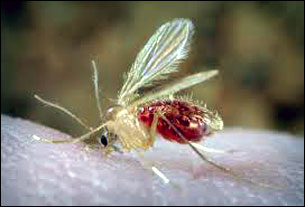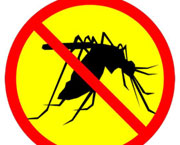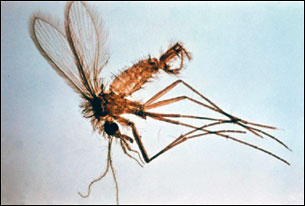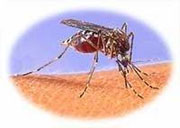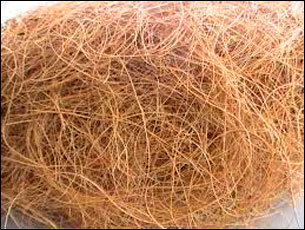|
E-Mail Edition Volume 11 Number 1 |
|||
|
Published Spring, 2014 Published by Piccadilly Books, Ltd., www.piccadillybooks.com. Bruce Fife, N.D., Publisher, www.coconutresearchcenter.org |
|
||
|
If you would like to subscribe to the Healthy Ways Newsletter |
Contents
|
||
|
|
What You Should Know About Insect Repellents
|
||
|
|
Have you ever been camping and as soon as the sun started to set, the creatures of the night came out of hiding and you felt like you had entered into mosquito hell? Some years ago (before I learned about the wonders of coconut oil) I took my family to a state park in southeastern Texas. The Brazos River ran through the park. We hiked around swamps and saw alligators, snakes, and other wildlife. It was a fun outing. We set up camp and planned on having a grand time sleeping out in the woods. It was summer and if you've ever been in southeastern Texas at that time of year you |
Ravenous sand fly.. |
|
|
|
know how hot and humid it can be. It was one of those sticky, sweltering nights. We didn't think to bring any insect repellent. To avoid being eaten alive by hordes of ravenous mosquitoes we slept inside a tent, with the flaps shut. It was so hot and muggy inside the tent that we slept on top of our sleeping bags. Although the tent kept most of the mosquitoes out, we itched and scratched all night long. In the morning we were covered in chigger bites. We scratched ourselves silly the rest of the day. Getting bitten by insects is no fun. I frequently travel to various parts of the world that have an abundance of biting and stinging insects. I avoid chemical insect repellents, opting for more natural solutions; my favorite being coconut oil. Although coconut oil is not as effective as DEET based repellents, it does provide a reasonable level of protection against sand flies, chiggers, misquitoes, and other annoying critters. One good thing about coconut oil, is that it has a neutralizing effect against insect bites and stings. Even if you are bitten, the toxic or irritating effects of the insects' saliva is greatly reduced. Bites that would ordinarily leave an angry, irritated, itchy welt are barely noticeable. Recently, I was invited to an area of the world where the climate is very hot and humid and diseases like yellow fever and malaria are serious problems. Travelers are strongly advised to get vaccines against a variety of infectious diseases, many of which are spread by insects. Since mosquitoes are a major source of infection, insect repellent is a must. Vaccination was not an option for me. I also try to avoid exposure to toxic chemicals in commercial lotions and sprays. Realizing that coconut oil alone may not be enough protection, I began an investigation to see what products, commercial or natural, were both safe and effective. This is a summary of that investigation.
Chemical Repellents DEET By far the most commonly used active ingredient in commercial insect repellents is DEET (N,N-Diethyl-meta-toluamide). It provides protection against mosquitoes, ticks, fleas, chiggers, and many other biting insects. DEET was developed for the United States Army following its experiences of jungle warfare during World War II. It was originally tested as a pesticide on farmland. The military adopted it in 1946 and since 1957 has been in public use. DEET is the longest-lasting repellent commercially available. Concentrations up to 100 percent (pure DEET), offers up to 12 hours of protection. Concentrations of 20-30 percent offer 3-6 hours of protection. The Centers for Disease Control and Prevention (CDC) considers a concentration of 30-50 percent to be sufficient for normal use. Drawbacks are that it has a distinctive unpleasant odor, is not very effective against flies, and can adversely affect fabrics, leather, plastics, auto paint, and other surfaces—hmm, if it can damage leather and plastics, what does it do to the skin? While DEET is promoted as being safe, it has a long list of reported side effects. It can irritate the skin and has been known to cause headaches, memory loss, dizziness, disorientation, agitation, hallucinations, tremors, seizures, shortness of breath, congestive heart failure, and death. Risk of experiencing side effects increases with frequent use or when the product is not completely washed off after several hours of use. People have had to go to the hospital because they failed to wash insect repellents off after extended use. Products containing DEET are required to include the following warning: "Do not apply over cuts, wounds, or irritated skin; do not apply to hands or near eyes and mouth of young children; do not allow young children to apply this product; use just enough repellent to cover exposed skin and/or clothing; do not use under clothing; after returning indoors, wash treated skin with soap and water; wash treated clothing before wearing it again; and, use of this product may cause skin reactions in rare cases." Doesn't quite sound like the harmless product it is portrayed does it? DEET is a neurotoxin—meaning it destroys nerve and brain cells. Do you really want to be slathering a neurotoxin all over your body? Duke Medical University pharmacologist Mohamed Abou-Donia, Ph.D conducted numerous studies in rats, which demonstrated that frequent and prolonged applications of DEET caused neurons to die in regions of the brain that control muscle movement, learning, memory and concentration. Rats treated with an average human dose of DEET (40 mg/kg body weight) performed far worse than control rats when challenged with physical tasks requiring muscle control, strength, and coordination. Further research by Dr. Abou-Donia shows even greater impact when DEET exposure occurs in combination with pharmaceuticals and other pesticides, including permethrin, an insecticide commonly used for public mosquito control. According to Dr. Abou-Donia, "Never use insect repellents on infants, and beware of using them on children in general. Never combine insecticides with each other or use them with other medications. Even an antihistamine could interact with DEET to cause toxic side effects."1
Picaridin Picaridin is a synthetic compound develop to resemble a natural compound called piperine, which is produced in black pepper. It was first used in Europe in 1998 and in the U.S. in 2005. In contrast to DEET, it has a more agreeable odor, does not adversely affect fabrics or plastics, and is more effective against flies, but does not last as long. Picaridin does not carry the same neurotoxicity risks as DEET but has not been as thoroughly tested or used as long either. It is commonly used in commercial products labeled "DEET-free" to appeal to those people who are concerned about the neurotoxic effects of DEET. Based on animal studies, the EPA considers the topical use of picaridin to be only slightly toxic in large doses. Animal studies showed inflammation and slight liver and kidney damage. Although it may be safer than DEET, it doesn't sound all that safe either.
IR3535 Ethyl butylacetylaminopropinate or simply IR3535 is another alternative to DEET that is believed to be less toxic. It is a synthetic biochemical pesticide that has been in use in Europe for about 30 years but was only approved for use in the US in 1999. It repels mosquitoes, deer ticks, lice, and biting flies. While IR3535 is considered to be relatively safe, since it is a synthetic chemical, there is the possibility of adverse effects. Some users have complained that when the chemical is on their skin, any cut or scratch, no matter how minor, can turn into an angry, inflamed welt. If it can cause a scratch to become inflamed and irritated, it is safe to assume it is not good to be inside the body. However, anytime it is applied to the skin, it's going to be absorbed into the body. I'll pass on this one too.
Clip-On Repellents Clip-on repellents provide head-to-toe insect protection without having to slather chemicals all over our bodies. The device attaches to the waistband or belt and with a small fan, propels an odorless insecticide out creating a protective cloud of fumes around the wearer. Manufacturers claim head-to-toe protection for up to 12 hours. The active ingredient in the insecticide is metofluthrin, a neurotoxin with potentially significant health risks affecting the brain and nervous system. The label says, "Avoid breathing vapor," but it's hard to imagine how, with the repellent constantly swirling around your body and face how you can manage this. Consumer Reports evaluated clip-on repellents in their August 2010 issue. They attached the repellent to the waists of four volunteers and every hour, for 12 minutes, had them one at a time sit in screened enclosures with 1,000 hungry, disease-free mosquitoes. Although the clip-on devices initially reduced the number of mosquitoes near the testers, two of them still received at least one bite each during their first session. That's less protection than they would get from skin-applied repellents. By the third session (2 hours after the devices were activated), the testing was stopped because the subjects were being severely bitten. Bottom line: clip-on repellents provide significantly less protection than topical repellents. Another major limitation to clip-on repellents is that they do not work if you are moving. When you walk, you move away from the protective cloud. So the devices can only be used if you are sitting, lying down, or standing still and if the weather is calm. They are worthless if you are walking the dog, riding a bike, on a moving boat, or if the wind is blowing.
Natural Repellents In contrast to synthetic repellents, there are natural repellents that are generally considered much safer. Most of these repellents are derived from the oils in plants. Most notably are essential oils—plant oils that are obtained by distillation and have the characteristic fragrance of the plant from with they are extracted. These oils produce strong odors that are offensive to mosquitoes and other insects and prevent them from landing and biting. Some oils are very effective insect repellents while others are not so good. Some oils reported to possess insect repellent properties include:
Citronella Oil Eucalyptus Oil Lemon Eucalyptus Oil Cinnamon Oil Castor Oil Rosemary Oil Lemongrass Oil Cedar Oil Peppermint Oil Clove Oil Geranium Oil Thyme Oil Neem Oil
Clove Oil Clove oil has a long history of use in dentistry as a topical anesthetic and antiseptic. The oil is applied directly to the gums to ease the pain caused by toothaches, reduce inflammation, and kill infection. Clove oil has very potent antibacterial, antiviral, and antifungal properties, which makes it useful as a disinfectant and antiseptic. It is also an effective insecticide and repellent. In an attempt to discover the most potent natural insect repellents, researchers in Thailand tested 38 essential oils with reported repellent properties. The investigators tested the oils at three different concentrations under laboratory conditions using human subjects. The tested oils were applied at 10 percent, 50 percent, and 100 percent concentrations. Most of the oils could not match the long-term effectiveness of DEET. The most effective oils evaluated in the study were citronella, patchouli, clove, and a Thai herb called makaen (Zanthoxylum limonella). At a concentration of 100 percent, these four oils provided 2 hours of complete repellency. Clove oil gave the longest duration of complete protection, up to 4 hours, against the three mosquito species tested.2 In a follow-up study the researchers tested the mosquito repellent properties of gel products containing either 20 percent clove oil or a mixture of 10 percent clove oil plus 10 percent makaen oil. The oil mixture showed complete protection for 4 hours and an efficiency of 95.7 percent after 5 hours. The 20 percent clove oil provided full protection for 4 hours and then 86.8 percent after 5 hours. In comparison, a DEET containing product showed similar protection up to 4 hours but dropped to 82.7 percent after 5 hours. Each of these three products all gave full protection for the first 4 hours with the two essential oil products outperforming the DEET product afterwards.3
Citronella Oil Citronella oil has been used for over 60 years as an insect repellent and fragrance. It is used in many familiar insect repellent products: candles, lotions, gels, sprays, and wipes. These products, which vary in efficacy, repel mosquitoes, biting flies, ticks, and fleas. Its pleasant lemon-like aroma gives it a distinct advantage over other insect repelling essential oils, which often have less pleasing fragrances. The major drawback to using citronella oil is its rapid volatility, which causes it to lose potency very quickly, requiring reapplication after 30 to 60 minutes. While it is highly effective, its rapid dispersal limits it use. Commercial repellents often use microencapsulated citronella oil in order to retard evaporation and prolong effectiveness. Citronella oil has been used since 1948 without any reported adverse effects and based on animal studies has shown to have little or no toxicity when used as a topical insect repellent. The US Environmental Protection Agency (EPA) states that when used according to the label, citronella products are not expected to cause harm to humans, pets, or the environment. In Europe, however, citronella oil was banned in 2006 as an active ingredient in insect repellents. Ironically, it can still be sold as a fragrance in perfume and soap, but must not be sold for use as an insect repellent. This law is based more on politics than on any concern about health.
Lemon Eucalyptus Oil Lemon eucalyptus is a close relative of the eucalyptus tree. Its oil is used for preventing mosquito and deer tick bites and for treating muscle spasms, toenail fungus, and osteoarthritis and other joint pain. It is also an ingredient in chest rubs used to relieve congestion. A test of various insect repellents by an independent consumer organization found that repellents containing DEET or picaridin are more effective than repellents with natural ingredients. All of the synthetic products gave almost 100 percent repellency for the first 2 hours, where the natural repellents were most effective for the first 30 to 60 minutes and required reapplication to be effective over several hours.4 The short duration of the effectiveness of essential oils is their biggest drawback. However, there are a few oils that do have sustained protection; one of these is lemon eucalyptus oil. The US Centers for Disease Control and Prevention (CDC) recognizes oil of lemon eucalyptus to be more effective than most other plant-based treatments, with a similar effectiveness of DEET.5 The CDC recommends equally four active ingredients for the topical application of insect repellent: DEET, picaridin, IR3535, and oil of lemon eucalyptus.6
Neem Oil One of the most promising natural insect repellents comes from the fruit and seed of the neem tree—an evergreen that is native to India. Technically, neem oil is not an essential oil because it is not produced by distillation but pressed from the seeds of the neem tree—similar to the extraction of olive or coconut oils. It has a strong odor, which no doubt contributes to its insect repelling properties. It is not known to be harmful to mammals or birds. Humans have been using it safely both topically and internally for generations. Neem oil is not used for cooking or as a food. It is used in soaps, hair products, creams, and medicines. Folk remedies use it to treat a wide variety of health conditions such as eczema, acne, fever, leprosy, malaria, and tuberculosis. Currently researchers are investigating its use as a treatment to fight cancer, speed the healing of wounds, prevent oral plaque and bacterial infections, and kill or repel parasites and blood sucking insects.7-11 It is an effective insecticide and is used in organic farming to repel mites, gnats, beetles, month larvae, aphids, caterpillars, locust, and other pests. It is also an effective fungicide and is used to control black spot, powdery mildew, and other fungi. It is used as a household bug repellent for ants, bedbugs, cockroaches, houseflies, sand flies, and mosquitoes. Neem oil has been a popular insect repellent for generations. Because neem oil is far cheaper to produce than most essential oils and less harmful than chemical repellents, researchers have investigated its effectiveness as an economical bug repellent. The traditional way to make insect repellent in the southern coastal areas of India is to mix a small amount of neem oil into coconut oil. In one study, concentrations of 1-4 percent neem oil combined with coconut oil was tested on the exposed body parts of human volunteers. The mixture was effective for up to 12 hours providing protection of 81 to 91 percent against mosquito bites.12 This is at least as good as a high concentration of DEET. Some species of mosquito are more tolerant to repellents than others. So effectiveness can vary from species to species. Neem oil at 2 percent concentration in coconut oil has proven to be effective against a variety of mosquito species including those that carry malaria and yellow fever.12-14 |
||
|
|
Sand flies, another noxious biting insect, is similarly repelled by a combination of neem and coconut oils. A concentration of 2 percent neem oil and 98 percent coconut oil was tested under laboratory and field conditions against sand flies. In the laboratory, the mixture provided 100 percent protection for 7 hours. In the field, under natural conditions, the mixture provided 100 percent protection throughout the night.15 The results were better than DEET, which in general, is less effective against flies than it is mosquitoes. The bite |
Sand Fly. |
|
|
|
from a sand fly is more irritating and lasts longer than a mosquito bite and, like a mosquito bite, can spread disease. Having an effective means of protection can be a lifesaver. Another study evaluated neem and chinaberry oils as repellents in laboratory and field populations of sand flies in Ethiopia. In the laboratory, concentrations of 2 percent and 5 percent neem oil mixed with coconut oil provided 96.28 percent protection up to a mean time of 7 hours and 20 minutes, and 98.26 percent protection up to 9 hours, respectively. Chinaberry oil at the same concentrations mixed in coconut oil provided about the same amount of protection.16 A 2 percent concentration of neem oil has proven to be highly effective as a topical insect repellent. Increasing the concentration to 5 percent extends the high degree of protection a few more hours. Neem oil can also be projected into the air to keep insects away. Kerosene lamps containing 1 percent neem oil were burned in the living rooms of villagers living near New Delhi, India. The neem oil-kerosene mixture proved to be highly effective in keeping mosquitoes at bay.17
Make Your Own Insect Repellent There are a number of commercial products that use essential oils as their active ingredients. Since some oils work better against certain types of insects, combining two or more oils provides a broader range of protection. Mixing oils also appears to have a synergistic effect, making them more potent overall. I don't trust the safety of repellents containing DEET and other man-made chemicals. Commercial repellents using essential oil and other natural ingredients are a better option, however, they often have ingredients I don't like putting on my skin, such as soybean oil. Soybean and other polyunsaturated vegetable oils are commonly used as the base in which essential oils are added, but these oils create an oily film and prematurely age the skin. You can make your own natural insect repellent that can be just as effective as those containing DEET. Clove, citronella, lemon eucalyptus, and neem oils are among the most effective. Choose one of these as your primary active ingredient. Adding another oil from this group or one from the list at the beginning of this article will enhance the effectiveness of the repellent. Essential oils can burn or irritate if applied directly to the skin, so they must be diluted with another, skin-safe oil. Coconut oil makes a perfect carrier oil. Coconut oil works better than other oils for this purpose, because of its soothing and healing nature it calms the irritating effects of the essential oils. This allows you the option to use a larger percentage of essential oil in the formula and thus make a stronger and longer lasting repellent. A teaspoon contains 120 drops or 5 ml. You can make a 4 percent solution by combining 5 drops of essential oil with 1 teaspoon of coconut oil. For example, 3 drops lemon eucalyptus oil and 2 drops neem oil mixed in 1 teaspoon of coconut oil would make a repellent with more potency than those used in most the above studies. Below are some measurements for making your own insect repellent.
At 4 percent concentration:
5 drops essential oil + 1 teaspoon (5 ml) coconut oil
15 drops essential oil + 1 tablespoon (15 ml) coconut oil
60 drops (or ½ tsp) essential oil + ¼ cup (60 ml) coconut oil
At 5 percent concentration:
6 drops essential oil + 1 teaspoon (5 ml) coconut oil
18 drops essential oil + 1 tablespoon (15 ml) coconut oil
72 drops essential oil + ¼ cup (60 ml) coconut oil
At 10 percent concentration:
12 drops essential oil + 1 teaspoon (5 ml) coconut oil
36 drops essential oil + 1 tablespoon (15 ml) coconut oil
144 drops essential oil + ¼ cup (60 ml) coconut oil
Rub the insect repellent onto exposed skin using care to avoid sensitive eye areas. You will need to reapply the product after swimming, heavy exercise, or if you sweat substantially as it will wash off the repellent. Unused repellent can be stored in a dark bottle away from heat or sunlight. When only a few mosquitoes are out, the low concentration mixture should be adequate protection. However, when mosquitoes are out in full force the higher concentration will provide more complete protection. Essential oils as well as neem and coconut oils are available at most health food stores. They are also available online. If you are bitten, avoid scratching as this irritates the skin and increases the itchiness and can possibly create an opening that will allow bacteria to enter and cause an infection. Apply pure coconut oil (not the repellent) to the bite several times a day. The coconut oil will help nullify the toxic effects of the insect saliva, soothe the itch, and speed healing. ■
References
|
||
|
|
|
||
|
World's Lightest Body Armor Made from Coconut Fiber
|
|||
|
|
The brown hairy husk of the coconut is known as coconut fiber or coir. This material is very strong and durable. It is used for multitude of purposes including floor mats, doormats, brushes, mattresses, rope, upholstery padding, floor titles, and fishing nets. Technically, coir is the fibrous material found between the hard, internal shell, and the outer skin of a coconut. Recently a new use for coir was found—body armor. The armor was invented by researchers at Universiti Teknikal Malaysia, Malacca (UTeM) and will be produced by Tembusu Resources Bhd in Malaysia. Tembusu Resources' managing director Mr. Mohd Ridhuan said he was attracted by the invention because its production would include 30 percent coconut fiber, which is a cheap renewable natural resource in Malaysia. The semi-organic body armor is reported to be the lightest body armor in the world. The entire suit weighs less than 3.5 kg (7.7 lb). In comparison, a Kevlar vest alone weighs this much. The coconut body armor is also much cheaper to produce. Mr. Ridhuan said his target market is local police and security personnel, adding that the company also plans to export the body armor to the Asian market. |
Coconut fiber.
Door mat made from coconut fiber. |
|
|
|
Bulletproof vests and body armor use layers of very strong fiber to "catch" and deform a bullet, mushrooming it into a dish shape, and spreading its force over a larger portion of the vest fiber. The vest absorbs the energy from the deforming bullet, bringing it to a stop before it can completely penetrate the textile matrix. Some layers may be penetrated but as the bullet deforms, the energy is absorbed by a larger and larger fiber area.
Coconut body armor and accompanying hard
plates that can be attached to the vest. Metal or ceramic plates can also be used with a soft vest, providing additional protection from rifle rounds, and metallic components or tightly woven fiber layers can give soft armor resistance to stab and slash attacks from knives and similar close-quarter weapons. Soft vests are commonly worn by police forces, private citizens, security guards, and bodyguards, whereas hard-plate reinforced vests are mainly worn by combat soldiers, police tactical units, and hostage rescue teams. ■
|
||
|
|
|||
|
|
New Study Proves Saturated Fat Does Not Cause Heart Disease Saturated fat has proven to be relatively benign while sugar poses a greater risk for heart disease
For many years the prevailing thought among the majority of health care professionals was that saturated fats promoted, if not caused, heart disease. We have been fed this line now for the past five decades. We've heard it so many times that we just assume that there is a mountain of evidence to back it up. However, the evidence has been sorely lacking. In fact, many studies have refuted this theory, but since these studies go contrary to the popular medical belief, they are generally ignored and forgotten. Only those studies that seem to support the saturated fat-heart disease hypothesis are given any recognition or publicity. However, a growing body of research challenging the saturated fat-heart disease connection is starting to convince many doctors to reconsider how they look at fats and heart disease. A new study published this week in the journal Annals of Internal Medicine showed beyond a reasonable doubt that saturated fats do not cause heart attacks and other cardiac events. The researchers discovered that saturated fats do not cause heart disease while so-called "healthy" polyunsaturated fats do not prevent cardiovascular problems. In contrast with decades old nutritional advice, researchers at Cambridge University have found that giving up fatty meat, cream, or butter is unlikely to improve health. They are calling for guidelines to be changed to reflect a growing body of evidence suggesting there is no overall association between saturated fat consumption and heart disease. "My take on this would be that it's not saturated fat that we should worry about" in our diets, said Dr. Rajiv Chowdhury, the lead author of the new study and a cardiovascular epidemiologist in the department of public health and primary care at Cambridge University. In the new research, Dr. Chowdhury and his colleagues sought to evaluate the best evidence to date. They conducted a "meta-analysis" of data from 72 studies involving more than 600,000 participants from 18 countries. The scientists also reviewed evidence from 27 randomized controlled trials – the gold standard in scientific research – that assessed whether taking polyunsaturated fat supplements like fish oil promoted heart health. The key finding was that total saturated fat, whether measured in the diet or the bloodstream, showed no association with heart disease. In addition, levels of so-called healthy polyunsaturated fats such as omega-3 and omega-6 had no general effect on heart disease risk. There was no less disease in those eating higher amounts unsaturated fat, including monounsaturated fat like olive oil or polyunsaturated fat like corn oil. Only omega-3 fatty acids found in fish was linked to a lower risk of heart disease. However, popular omega-3 and omega-6 supplements appeared to have no benefit. The researchers did find a link between trans fats, produced when vegetables oils are hydrogenated. Partially hydrogenated vegetables oils and are commonly found in processed foods. But they found no evidence of dangers from saturated fat, or benefits from other kinds of fats. The primary reason saturated fat has historically had a bad reputation is that it increases low-density lipoprotein cholesterol, or LDL, the kind that has been assumed to raise the risk for heart attacks. But the relationship between saturated fat and LDL is complex, said Dr. Chowdhury. In addition to raising LDL cholesterol, saturated fat also increases high-density lipoprotein, or HDL, the so-called good cholesterol that has shown to protect against heart disease. And the LDL that it raises is a subtype of big, fluffy particles that are generally benign. The smallest and densest form of LDL is more dangerous. These particles are easily oxidized and are more likely to set off inflammation and contribute to the buildup of artery-narrowing plaque. An LDL profile that consists mostly of these particles usually coincides with high triglycerides and low levels of HDL, both risk factors for heart attacks and stroke. The smaller, more artery-clogging particles are increased not by saturated fat, but by sugar, sugary foods, and an excess of carbohydrates, Dr. Chowdhury said. "It's the high carbohydrate or sugary diet that should be the focus of dietary guidelines," he said. "If anything is driving your low-density lipoproteins in a more adverse way, it's carbohydrates." While the new research showed no relationship overall between saturated or polyunsaturated fat intake and cardiac events, there are numerous unique fatty acids within these two groups, and there was some indication that they are not all equal. When the researchers looked at fatty acids in the bloodstream, for example, they found that margaric acid, a saturated fat in milk and dairy products, was associated with lower cardiovascular risk. Two types of omega-3 fatty acids, the polyunsaturated fats found in fish, were also protective. But a number of the omega-6 polyunsaturated fatty acids, commonly found in corn, soybean, and other vegetable oils and processed foods, may pose risks, the findings suggested. The researchers then looked at data from the randomized trials to see if taking supplements like fish oil produced any cardiovascular benefits. It did not. But Dr. Chowdhury said there might be a good explanation for this discrepancy. The supplement trials mostly involved people who had pre-existing heart disease or were at high risk of developing it, while the other studies involved generally healthy populations. So it is possible that the benefits of omega-3 fatty acids lie in preventing heart disease, rather than treating or reversing it. At least two large clinical trials designed to see if this is the case are currently underway. Despite the clear evidence presented in this and many other studies, it will take a long time before doctors change their way of thinking. Most are so entrenched with the belief that saturated fats are harmful that they will continue to stick with the old beliefs. Dr. Frank Hu, a professor at the Harvard School of Public Health, who was not involved in the study, said the findings should not be taken as "a green light" to eat more steak, butter, and other foods rich in saturated fat. In other words, we should not abandon old ways simply because new science proves otherwise. In like manner, Bruce Griffin, professor of nutritional metabolism at the University of Surrey, who also was not involved in the study, cautions against taking this study to literally, "To suggest that the theory relating saturated fat to increased total cholesterol is flawed, is nonsense, and contradicts 50 years of evidence based medicine." What he is inferring is that we should ignore new evidence because it contradicts a generally accepted and loved theory. Note that the saturated fat-heart disease connection is just a theory. After 50 years of research no one has yet to prove it, but many studies have disproven it, including the current study. Alice H. Lichtenstein, a nutritional biochemist at Tufts University, agreed that "it would be unfortunate if these results were interpreted to suggest that people can go back to eating butter and cheese with abandon." Dr. Lichtenstein, who also was not involved in the latest study, was the lead author of the American Heart Association's (AHA) dietary guidelines, which recommend that people restrict saturated fat to as little as 5 percent of their daily calories, or roughly two tablespoons of butter or two ounces of cheddar cheese for the typical person eating about 2,000 calories a day. The heart association states that restricting saturated fat and eating more unsaturated fat, beans and vegetables can protect against heart disease by lowering LDL cholesterol. However, according to this new study Dr. Lichtenstein and the AHA are wrong. Saturated fat increases HDL (the good) cholesterol and the large (benign) LDL. It does not increase the small (harmful) LDL, that's what sugar does. This is not the first time that the AHA policies have clashed with science. It makes one wonder whose interests the AHA represents—the people, or the pharmaceutical industry who make billions of dollars selling drugs to treat high cholesterol, telling us to avoid saturated fat but eating sugar is okay. The AHA will continue to sell its outdated theory of heart disease and caution against the use of saturated fats despite this and similar studies. Your doctor, unfortunately, will continue to be misled and confused about the issue. ■
|
||
|
|
|||
|
|
GMOs: Ban Them or Label Them?
By Ronnie Cummins
|
||
|
|
Since the controversial introduction in the mid-nineties of genetically engineered (GE) food and crops, and the subsequent fast-tracking of those crops by the federal government—with no independent safety-testing or labeling required—there has been a lively debate among activists, both inside and outside the U.S., about how to drive these unhealthy and environmentally destructive "Frankenfoods" off the market. Some campaigners have called for an outright ban of GE crops. In fact, several dozen nations, thousands of local governments in the EU, and six counties in the U.S. (in California, Washington and Hawaii) have created GMO-free zones by passing bans. Other activists argue that strict mandatory labeling laws, similar to those in the EU, are all we need in order to rid the world of GMOs (Genetically Modified Organisms). Activists in this camp point out that very few products in countries that have mandatory GMO labeling laws contain GMOs, because once companies are required to label GMO ingredients, they reformulate their products to be GMO-free, rather than risk rejection by consumers. Who's right? A review of two decades of anti-GMO campaigning in North America and Europe suggests that mandatory labeling and bans, or GMO-free zones, should be seen as complementary, rather than contradictory. And recent news about increased contamination of non-GMO crops by the growing number of USDA-approved GMO crops suggests that if we don't implement labeling laws and bans sooner rather than later, we may run out of time to preserve organic and non-GMO farmers and their fields.
In the EU in the late-1990s, in what was the largest agricultural market in the world, anti-GMO campaigners, including Greenpeace and Friends of the Earth, at first tried to establish a sweeping production and import ban on all GMOs. They were unsuccessful, largely because politicians and bureaucrats argued that an outright ban of GMOs in the EU would violate World Trade Organization agreements and bring on serious economic retaliation from the U.S. government. Leading consumer, environmental and farm groups pushing for a ban were successful, however, in forcing EU authorities to adopt significant GMO safety-testing regulations. All GMOs, under EU law, are considered "novel foods" and are subject to extensive, case-by-case, science-based food evaluation by European regulatory officials. These regulations, much to the chagrin of Monsanto and the Gene Giants, have kept most GMOs, with the exception of animal feeds, out of the country.
EU regulations also permit member nations to establish GMO-free
zones. As of 2012 there are 169 regions and 4,713
municipalities that have
declared themselves GMO-free zones in the EU. In addition to
these GMO-free zones in the EU, at least 26 nations, including
Switzerland, Australia, Austria, China, India, France, Germany,
Hungary, Luxembourg, Greece, Bulgaria, Poland, Italy, Mexico, and
Russia have banned GMOs entirely. Significant labeling and
safety-testing procedures on GMOs have been put in place in
approximately
60 countries.
Although EU grassroots forces failed to gain a continent-wide ban on
the cultivation or import of GMOs, they were successful in pushing
authorities to impose mandatory labeling of all genetically
engineered foods, feeds and food ingredients in 1997. This, combined
with strict pre-market safety-testing regulations, has marginalized
or eliminated GMOs throughout the EU. As the EU's GMO food labeling law came into effect in 1997-98, activists switched gears, successfully pressuring many large supermarket chains, including Carrefour, Co-Op, Tesco, Waitrose and Marks & Spencer, and food manufacturers, including Unilever and Nestlé, to pledge to remain GMO-free. Feeling the heat from grassroots campaigners and realizing that mandatory GMO labeling would be the "kiss of death" for their brand-name products and their reputations, every major EU supermarket, food manufacturing and restaurant chain, including U.S.-based multinationals such as General Mills, Kellogg's, McDonald's, Starbucks and Walmart, eliminated GMOs from their supply chains. As a consequence almost no GMO-derived foods, with the exception of meat and animal products, have been sold in EU retail stores or restaurants from 1997 until now.
With no real market for GMOs, EU farmers have refused to grow them.
EU activists point out that if meat, eggs and dairy products derived
from animals fed GMO grains had to be labeled, there would be no
GMOs in Europe. Period. In the U.S., the battle against GE foods and crops has been markedly more difficult. Since 1994, government regulatory agencies have refused to require labels on GMOs, or to require independent safety testing beyond the obviously biased research carried out by Monsanto and other genetic engineering companies themselves. Despite government and industry opposition, and limited funding, a growing number of pro-organic and anti-GMO campaigners carried out a variety of public education, marketplace pressure and boycotts between 1994 and 2012 designed to either ban or label GMOs. Although GMO labeling bills, which according to numerous polls are supported by the overwhelming majority of Americans, were introduced in Congress over and over again during the past two decades, none have gathered more than nominal support from lawmakers And media coverage, at least until the California GMO labeling ballot initiative in 2012 (Proposition 37) and the Washington State ballot initiative in 2013 (I-522), has been generally sparse, with reporters routinely spouting industry propaganda that GMOs are safe, environmentally sustainable and necessary to feed a growing global population.
But the tide is beginning to turn. More farmers are rejecting GMO
seeds, more consumers are demanding non-GMO foods, or at the least,
labels on GMO foods. And the media is beginning to give the anti-GMO
movement if not its fair share, at least substantially more ink than
we've seen in decades. Between 1994-2012, the number of acres in the U.S. planted in GMO crops has grown significantly. Today, 169 million acres—almost half of all cultivated U.S. farmlands—are now growing GMO crops. But despite the proliferation of GMO crops, we're now seeing increased demand for non-GMO seeds. This is partly because farmers are growing frustrated with having to buy more and more pesticides and herbicides for GMO crops, as weeds and pests grow increasingly resistant to products like Monsanto's Roundup.
But it's also because organic and non-GMO farmers are speaking out
about contamination of their crops by nearby GMO crops. Just this
week, a
new survey published by Food & Water Watch revealed that a third
of U.S. organic farmers report problems with contamination from
nearby GMO crops, and over half of the farmers surveyed said they've
had grain shipments rejected because of contamination. Increasing demand for non-GMO crops also stems from consumers' heightened concerns about health, which in turn is increasing demand for non-GMO and organic crops and foods. The turning point in the anti-GMO Movement in the U.S. came in 2012-13 when organic and anti-GE organizations, led by the Organic Consumers Association, Food Democracy Now, Center for Food Safety, Alliance for Natural Health and others, joined by a number of organic and natural health companies including Mercola.com, Dr. Bronner's Soaps, Nature's Path, Lundberg Family Farms, Natural News, and Nutiva, decided to bypass the federal government and launch high-profile, multi-million dollar state ballot initiative campaigns for mandatory labeling of GMOs in California and Washington State. Although anti-GMO campaigners narrowly lost 51%-49% in both states, large genetic engineering and food corporations were forced to spend over $70 million ($12 million of which was illegally laundered by the Grocery Manufacturers Association in Washington). In addition GMA members, most of whom are high-profile food manufacturers, seriously damaged their brands and reputations by carrying out a misleading, dirty tricks advertising campaign that flooded the airwaves in California and Washington and antagonized millions of consumers—many of whom began boycotting their products and assailing their Facebook pages.
By 2012, thanks to the massive media coverage of the California GMO
labeling initiative, organic foods and products reached $35 billion
in sales, representing almost 5 percent of all grocery store sales,
with non-GMO "natural" food sales reaching another $15 billion. In the meantime, grassroots activists continue to push for mandatory labeling laws. In 2012-13, they lobbied legislators in 30 states, achieving partial success in Maine and Connecticut. In 2014 Vermont, Oregon and several others states appear poised to pass GMO labeling laws, while voters in five Oregon and California counties will attempt to pass GMO bans.
Frantically trying to head off the inevitable, the GMA and a
powerful coalition of genetic engineering, industrial agriculture,
restaurant, supermarket and junk food manufacturers have begun
lobbying Congress to take away states' rights to pass laws requiring
GMO food labels. The GMA has also lobbied the FDA and Congress to
allow the obviously fraudulent, though routine, industry practice of
labeling or marketing GE-tainted foods as "natural." On the international front, genetic engineering, pharmaceutical and Big Food companies are attempting to subvert GMO labels or bans by "fast-tracking," with no public input or discussion, transnational trade agreements such as the Trans Pacific Partnership (TPP) and the Trans Atlantic Free Trade Agreement (TAFTA). These so-called Free Trade agreements would allow multinational corporations such as Monsanto, Bayer and Dupont to sue local, state or even national governments that interfere with their profits, by passing laws regulating or banning GMOs or other controversial agricultural practices.
Although these profoundly pro-corporate and anti-consumer and
anti-environmental trade agreements in theory can stop GMO labeling
laws and bans from coming into effect, in political terms they are
perceived by the majority of the body politic and even many state
and local officials as highly authoritarian and anti-democratic.
Similarly TPP and TAFTA are correctly perceived by many national
political, environmental and labor leaders as undermining national
sovereignty, sustainability and economic justice. Once GMOs foods are labeled, informed consumers will move to protect themselves and their families by not buying them. Once enough consumers shun GMO-tainted and labeled foods, stores will stop selling them and food manufacturers will stop putting GMO food ingredients in their products. However as the EU experience shows, labeling must eventually be comprehensive, with a requirement for meat, eggs and dairy products to be labeled if the animals have been fed GMO feed.
But food labeling alone cannot protect the environment, or non-GMO
and organic farmers from GE drift and seed contamination. This is
why county and regional bans on GMO cultivation and the creation of
regional GMO-free zones are important. More than 80 percent of
farmers surveyed by Food & Water Watch said they were "concerned"
about contamination, while 60 percent said they were "very
concerned." Farmers said a lax U.S. Department of Agriculture (USDA)
has been excessively influenced by the biotech industry. In the U.S. the largest food fight in history will soon intensify. Throwing gasoline on the fire, GE companies are arrogantly and foolhardily attempting to introduce genetically engineered fish, apples and "Agent Orange" (2,4 D) herbicide-resistant corn and soy on the market, just at the time when human health and environmental concerns are escalating. These new Frankenfoods and crops will survive in the marketplace only if there are no mandatory labeling laws and no legitimate safety testing. But this "no labels" scenario is unlikely to continue. State legislative battles in Vermont, Oregon, and other states will likely reach critical mass in 2014, forcing industry and the federal government to finally adopt EU-type regulations and practices on GMOs. Once labeling is in place (including labels on meat, fish dairy, and eggs) genetic engineering companies, led by Monsanto, Dow, Dupont, Syngenta, Bayer, and BASF will have no choice but to abandon GMOs and gene-splicing, in favor of less controversial hybrid seed/cross-breeding practices (which do not require labels) such as "marker assisted breeding." If industry and government on the other hand dig in their heels, stomping on consumer, state, municipal and community rights, telling us to "shut up and eat your Frankenfoods," America's food revolution may turn into a full-scale rebellion.
America's organic consumers and natural health advocates invite you
to join us in this decisive battle to drive GMOs off the market and
make the great transition to healthy and sustainable food and
farming.
Click here to make a donation to this cause, the Food Fight of
Our Lives. ■
|
||
|
|
|||
|
|
Announcing the newest book by Bruce Fife, ND
The Coconut Ketogenic Diet Supercharge Your Metabolism, Revitalize Thyroid Function, and Lose Excess Weight
|
||
|
You can enjoy eating rich, full-fat foods and lose weight without counting calories or suffering from hunger. The secret is a high-fat, ketogenic diet. Our bodies need fat. It's necessary for optimal health. It's also necessary in order to lose weight safely and naturally. Low-fat diets have been heavily promoted for the past three decades, and as a result we are fatter now than ever before. Obviously there is something wrong with the low-fat approach to weight loss. There is a better solution to the obesity epidemic, and that solution is The Coconut Ketogenic Diet. This book exposes many common myths and misconceptions about fats and weight loss and explains why low-fat diets don't work. It also reveals new, cutting-edge research on one of the world's most exciting weight loss aids—coconut oil—and how you can use it to power up your metabolism, boost your energy, improve thyroid function, and lose unwanted weight. This revolutionary weight loss program is designed to keep you both slim and healthy using wholesome, natural foods, and the most health-promoting fats. It has proven successful |
 |
||
|
|
in helping those suffering from obesity, diabetes, heart and circulatory problems, low thyroid function, chronic fatigue, high blood pressure, high cholesterol, and many other conditions.
You will learn:
To learn more about the book or to place an order click here
|
||
|
|
|||
|
Do you have friends who would like this newsletter? If so, please feel free to share this newsletter with them.
If this newsletter was forwarded to you by a friend and you would like to subscribe, click here.
Copyright © 2014, Bruce Fife. All rights reserved.
|
|||
